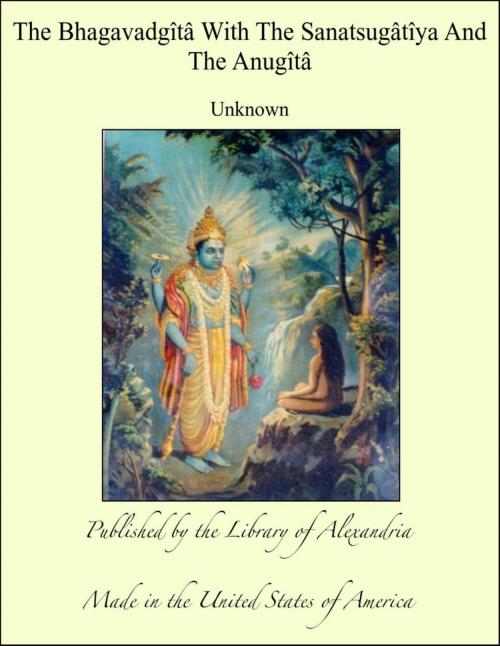The Bhagavadgîtâ With The Sanatsugâtîya And The Anugîtâ
Nonfiction, Religion & Spirituality, New Age, History, Fiction & Literature| Author: | Unknown | ISBN: | 9781465580658 |
| Publisher: | Library of Alexandria | Publication: | March 8, 2015 |
| Imprint: | Language: | English |
| Author: | Unknown |
| ISBN: | 9781465580658 |
| Publisher: | Library of Alexandria |
| Publication: | March 8, 2015 |
| Imprint: | |
| Language: | English |
IT has become quite a literary commonplace, that--to borrow the words of Professor Max Müller in one of his recent lectures--history, in the ordinary sense of the word, is almost unknown in Indian literature1. And it is certainly a remarkable irony of fate, that we should be obliged to make this remark on the very threshold of an introduction to the Bhagavadgîtâ; for according to the eminent French philosopher, Cousin2, this great deficiency in Sanskrit literature is due, in no inconsiderable measure, to the doctrines propounded in the Bhagavadgîtâ itself. But however that may be, this much is certain, that the student of the Bhagavadgîtâ must, for the present, go without that reliable historical information touching the author of the work, the time at which it was composed, and even the place it occupies in literature, which one naturally desires, when entering upon the study of any work. More especially in an attempt like the present, intended as it mainly is for students of the history of religion, I should have been better pleased, if I could, in this Introduction, have concentrated to a focus, as it were, only those well ascertained historical results, on which there is something like a consensus of opinion among persons qualified to judge. But there is no exaggeration in saying, that it is almost impossible to lay down even a single proposition respecting any important matter connected with the Bhagavadgîtâ, about which any such consensus can be said to exist. The conclusions arrived at in this Introduction must, therefore, be distinctly understood to embody individual opinions only, and must be taken accordingly for what they are worth. The full name of the work is Bhagavadgîtâ. In common parlance, we often abbreviate the name into Gîtâ, and in Sanskrit literature the name occurs in both forms. In the works of Sankarâkârya, quotations from the Gîtâ are introduced, sometimes with the words 'In the Gîtâ,' or 'In the Bhagavadgîtâ,' and sometimes with words which may be rendered 'In the Gîtâs,' the plural form being used1. In the colophons to the MSS. of the work, the form current, apparently throughout India, is, 'In the Upanishads sung (Gîtâs) by the Deity.' Sankarâkârya, indeed, sometimes calls it the Îsvara Gîtâ2, which, I believe, is the specific title of a different work altogether. The signification, however, of the two names is identical, namely, the song sung by the Deity, or, as Wilkins translates it, the Divine Lay.
IT has become quite a literary commonplace, that--to borrow the words of Professor Max Müller in one of his recent lectures--history, in the ordinary sense of the word, is almost unknown in Indian literature1. And it is certainly a remarkable irony of fate, that we should be obliged to make this remark on the very threshold of an introduction to the Bhagavadgîtâ; for according to the eminent French philosopher, Cousin2, this great deficiency in Sanskrit literature is due, in no inconsiderable measure, to the doctrines propounded in the Bhagavadgîtâ itself. But however that may be, this much is certain, that the student of the Bhagavadgîtâ must, for the present, go without that reliable historical information touching the author of the work, the time at which it was composed, and even the place it occupies in literature, which one naturally desires, when entering upon the study of any work. More especially in an attempt like the present, intended as it mainly is for students of the history of religion, I should have been better pleased, if I could, in this Introduction, have concentrated to a focus, as it were, only those well ascertained historical results, on which there is something like a consensus of opinion among persons qualified to judge. But there is no exaggeration in saying, that it is almost impossible to lay down even a single proposition respecting any important matter connected with the Bhagavadgîtâ, about which any such consensus can be said to exist. The conclusions arrived at in this Introduction must, therefore, be distinctly understood to embody individual opinions only, and must be taken accordingly for what they are worth. The full name of the work is Bhagavadgîtâ. In common parlance, we often abbreviate the name into Gîtâ, and in Sanskrit literature the name occurs in both forms. In the works of Sankarâkârya, quotations from the Gîtâ are introduced, sometimes with the words 'In the Gîtâ,' or 'In the Bhagavadgîtâ,' and sometimes with words which may be rendered 'In the Gîtâs,' the plural form being used1. In the colophons to the MSS. of the work, the form current, apparently throughout India, is, 'In the Upanishads sung (Gîtâs) by the Deity.' Sankarâkârya, indeed, sometimes calls it the Îsvara Gîtâ2, which, I believe, is the specific title of a different work altogether. The signification, however, of the two names is identical, namely, the song sung by the Deity, or, as Wilkins translates it, the Divine Lay.















